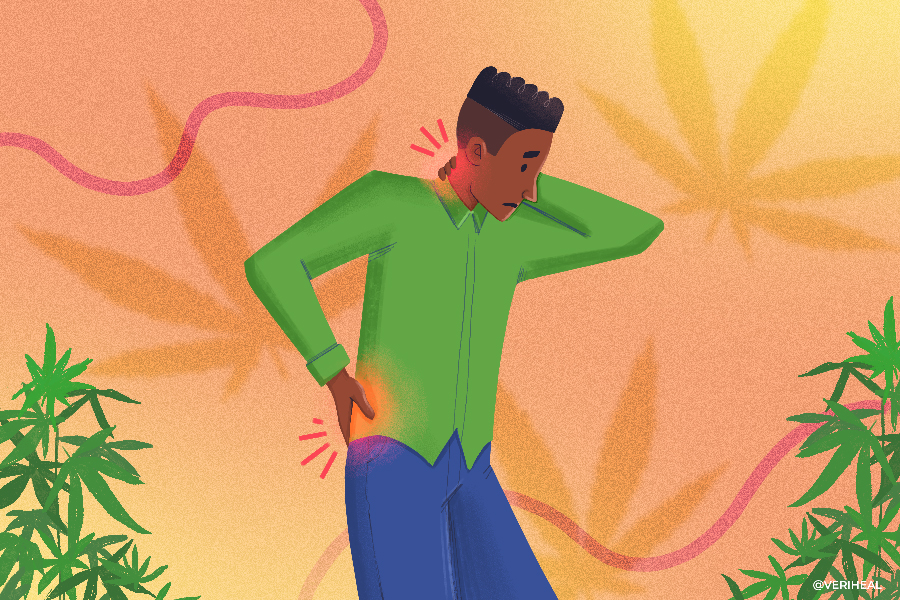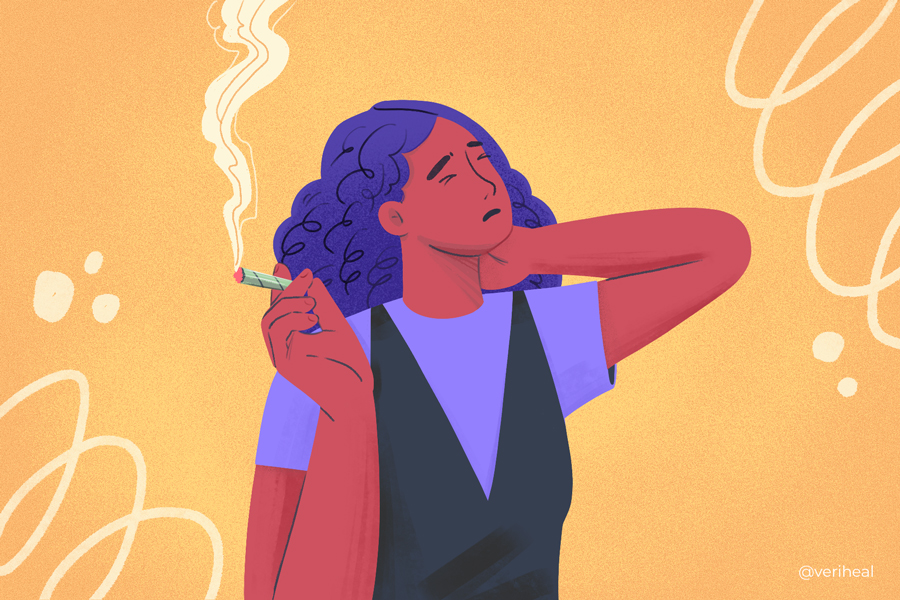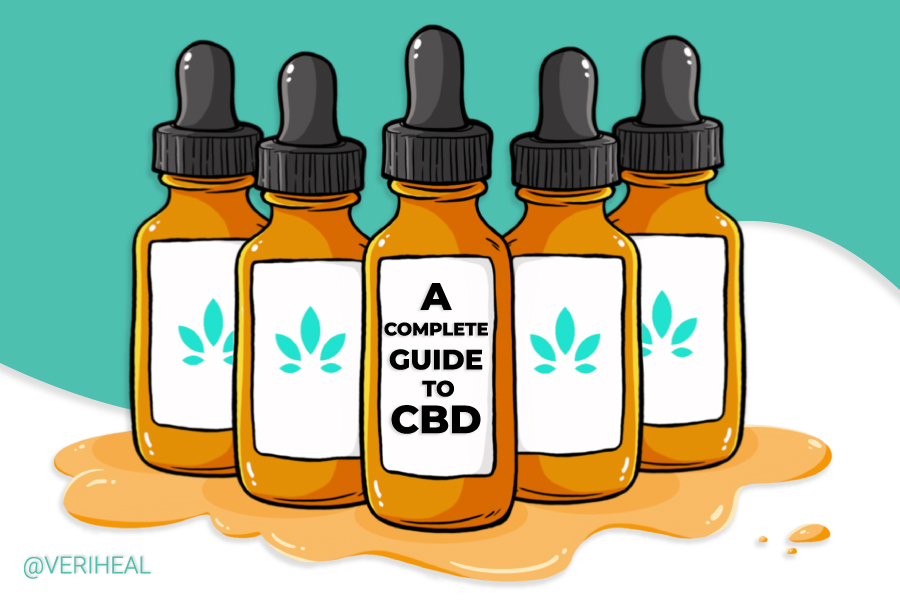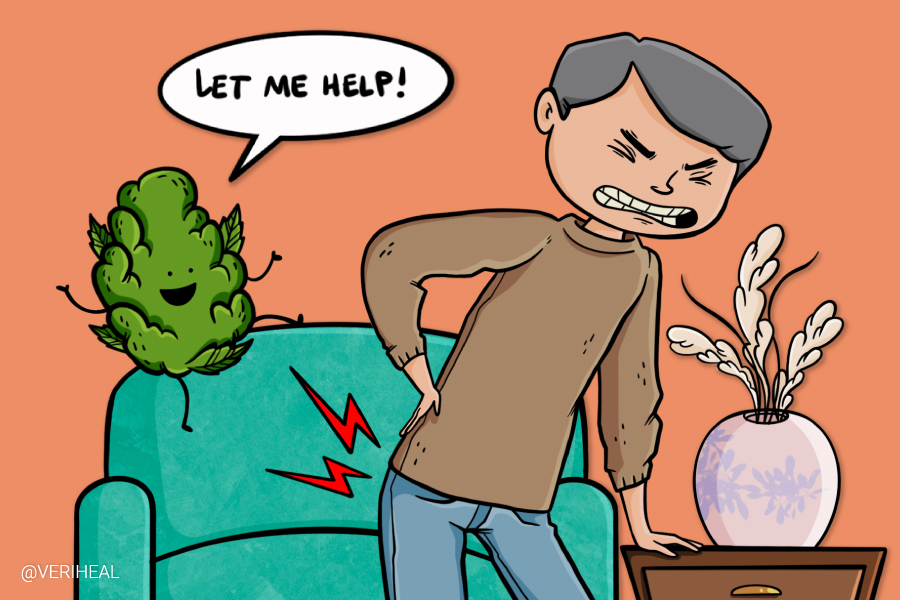Can Medical Marijuana Help Back Pain?

Key Takeaways: Medical Cannabis for Back Pain
Medical cannabis, particularly CBD and THC, shows promise in relieving symptoms like muscle spasms and inflammation through interactions with the body’s endocannabinoid system.
Different preparations of cannabis, including edibles, topical solutions, pills, and tinctures, offer various options for back pain management. CBD products, which do not induce psychoactive effects, are particularly popular for those seeking relief without a high.
Understanding back pain symptoms, causes, and complications is crucial for exploring treatment options, including complementary therapies like acupuncture or massage alongside traditional treatments. Consulting with a medical professional is essential for personalized treatment plans.
The Science Behind Medical Cannabis for Back Pain
- Are Cannabinoids a Good Treatment Option for Back Pain?
- How Does the Endocannabinoid System Play a Role in Treating Back Pain?
- What Cannabis Preparations Are Suitable for Back Pain?
- What are the Signs, Symptoms, & Types of Back Pain?
Back pain is one of the most common reasons why people seek the help of a medical professional or are unable to attend work (12). Data published by Statista indicates that in 2019, 39% of adults in the United States over the age of 18 experienced some back pain in the past three months. Furthermore, it is a leading cause of disability worldwide.
Back pain can affect the entire back, but the majority of people suffer pain in the lower region. There are many myths about back pain, with one of the biggest misconceptions being that surgery is necessary, but this is by no means true. Lower back pain can be considered a serious medical condition and could disrupt daily life, but it’s also possible to treat.
Approximately a third of Americans have used medical marijuana to relieve the symptoms of chronic pain. This is based on the findings of a study conducted by a team of researchers at Michigan Medicine. The results were gleaned after the team surveyed 1,661 adults who reported experiencing chronic pain as a qualifying condition and resided in a medical cannabis-friendly state (3).
Are Cannabinoids a Good Treatment Option for Back Pain?
Many patients are turning to medical cannabis for pain control and to help relieve a variety of related symptoms, including:
- Lower back pain
- Neck pain
- Acute pain
- Chronic pain
- Muscle spasms & cramps
- Nerve pain, also known as neuropathy
- Swelling and inflammation
- Depression & Anxiety
- Sleep disturbances such as insomnia
Even with over-the-counter medication, persistent back pain can affect the quality of life of those who suffer. Consequently, patients are often left exploring additional therapies. One such example is cannabis, which is naturally laden with therapeutic compounds called cannabinoids. Although few studies have specifically explored the use of cannabis for back pain and low back pain, the evidence supporting cannabis for chronic pain is stacking up.
Human trials have demonstrated that the two most abundant cannabinoids — Δ9-tetrahydrocannabinol (THC) and cannabidiol (CBD) — may reduce pain and inflammation. A 2021 study found that a 1:1 ratio of CBD and THC more effectively treats neuropathic back pain and is better tolerated than long-acting opiates (8). CBD may also cause levels of anandamide (AEA) – an endogenous cannabinoid that relieves pain – to soar (15).
The National Academies of Sciences, Engineering, and Medicine supports treating chronic pain with cannabis (13). A study carried out in early 2021 explored the effects of cannabinoid drugs on pain levels by safely applying experimental heat pain before assessing nervous system response. Using pure CBD oil, researchers learned that CBD had pain-relieving effects, but didn’t reduce the pain volume of patients (7).
According to the Americans for Safe Access Foundation (ASAF), a pro-medical marijuana lobbyist group, the plant in its natural form of marijuana contains significantly more cannabinoids (as well as THC) than dronabinol, a man-made version of THC isolate (6).
Dronabinol is available as a prescription that is FDA-approved for treating chemotherapy-related nausea and weight loss in HIV patients. Unfortunately, dronabinol is not yet approved for back pain management and is only available for a few medical conditions. It is out of reach for many pain patients.
How Does the Endocannabinoid System Play a Role in Treating Back Pain?
Patients who use medical marijuana experience its benefits through its interactions in the body. This is through a system of receptors that are able to increase or decrease the levels of endocannabinoids in the body.
Endocannabinoids are fatty-based neurotransmitters that send signals to cells in various places of the body. This system is called the endocannabinoid system. It serves as the entry portion of the endocannabinoidome (eCBome).
The endocannabinoidome is responsible for a variety of processes in the body. It plays a role in pain perception and nausea, the gut-brain-microbiome axis, as well as how the immune system functions during illnesses and inflammation.
There are several different cellular pathways that the eCBome works through to help relieve pain when exposed to compounds in the cannabis plant. These pathways depend on what type of pain a patient is experiencing.
Please check out our pages on chronic pain and acute pain for more information.
What Cannabis Preparations Are Suitable for Back Pain?
Various cannabis preparations are available for purchase from dispensaries such as edibles, topical solutions, pills, vapes, and tinctures. For those who do not wish to experience psychoactive effects, CBD products interact with the body’s endocannabinoid system without inducing a high.
Edibles and pills release their effects much slower than vapes or tinctures, so you may want to consider this if you’re dealing with severe spontaneous pain.
Transdermal patches, CBD-infused gummies, and dissolvable cannabis powder are other cannabis products worth discussing with a certified medical marijuana doctor or cannabis coach.
What are the Signs, Symptoms, & Types of Back Pain?
Back pain can vary from a lingering, dull ache to a sharp shooting pain in the leg.
Problems with various structures in the anatomy of the back can result in back pain. According to the National Institute of Arthritis and Musculoskeletal and Skin Diseases (NIAMS), the three main types of back pain are (4):
- Acute Back Pain – Symptoms surface without warning and last anywhere from a few days to weeks.
- Subacute Back Pain – Can happen unexpectedly and linger for 4-12 weeks.
- Chronic Back Pain – Discomfort may happen suddenly or slowly. Chronic back pain typically lasts longer than 12 weeks and occurs daily.
A patient may experience back pain that only involves only portions of the back. The pain can also radiate and spread into the buttocks, legs, or abdomen (4). Depending on what is causing the pain, some common pain symptoms may include (4):
- Back pain that comes and goes
- Pain that increases when lifting or bending
- Increased pain when lying down, sitting, or standing
- Back stiffness after waking up in the morning
- Pain that decreases with activity
- Pain that spreads into the hips, legs, or buttocks.
- Numbness of weakness in the legs or feet
- Neuropathic pain including tingling or burning sensations
There are several muscles, ligaments, and tendons that hold the spine in place and help us move. Sometimes these soft tissues can get torn or pulled, resulting in pain. Patients may also experience pain caused by pinched or damaged nerves as well as from the spine itself.
The following are the main sections of the spine (4). These locations are important as they can help doctors determine a cause for your pain. There are four main regions of the spine that may suffer from injuries, thus resulting in chronic back pain:
- Cervical spine- this is the portion of the spine that begins at the base of the head and supports the neck
- Thoracic spine- this portion is below the cervical spine and goes from your shoulders to the beginning of the lower back
- Lumbar spine- this is the lower back
- Sacrum and coccyx- this begins at the hips and concludes with the tailbone
The sections of the spine can all be broken down into smaller parts. Some terms you may hear your doctor use include (4):
- Vertebrae – Small bones stacked atop one another. Their job is to shield the spinal cord.
- Spinal Cord – A long cord of nerves that extends down the spine through a canal in the vertebrae.
- Intervertebral Discs – Spongy protective pads nestled between each vertebra. The discs separate each bone and act like cushions.
- Ligaments – Flexible yet tough tissues that hold the vertebrae in place.
- Tendons – A cord of tissue that attaches muscle to bone.
- Muscles – A collection of powerful fibers that support your spine and upper body, and assist with mobility.
Back Pain: Causes and Complications
Spontaneous back pain can happen after an accident, fall, or from lifting heavy items. Alternatively, it may develop slowly and progressively due to age-related degenerative changes in the spine. It is also possible for inflammatory arthritis disorders and other medical conditions to spark back pain problems.
Some possible causes of back pain include (2):
- Ankylosing spondylitis
- Endometriosis
- Fibromyalgia
- Herniated disk
- Kidney infection (pyelonephritis)
- Kidney stones
- Obesity
- Osteoarthritis
- Osteomyelitis
- Osteoporosis
- Poor posture
- Pregnancy
- Strained muscles
- Sacroiliitis
- Sciatica
- Scoliosis
- Spinal cord tumor
- Spinal fractures
- Spinal stenosis
- Spondylolisthesis
- Sprains
Age, genetics, stress levels, weight gain, and fitness level are a few factors that contribute to back pain. Additionally, people who work jobs requiring strenuous lifting, bending, or pulling may be at higher risk of developing back pain. People who sit in a chair all day or have poor posture are also at risk for back pain.
Talking to Your Doctor About Back Pain Diagnosis and Treatment
Before meeting with a doctor about back pain treatments, you must first get diagnosed by a medical professional. The physician will ask a few questions to better picture the problem and pain level.
The doctor will examine your posture and spine for bone structure changes, as well as test your muscle strength, sensation, and reflexes.
Additional testing may also be necessary, such as magnetic resonance imaging (MRI), X-ray imaging, blood tests, and electrophysiological tests, such as electromyography (EMG), and computerized axial tomography (CAT).
Most back pain episodes are treated effectively with topical or oral nonsteroidal anti-inflammatory drugs (NSAIDs), including ibuprofen and naproxen. Other pain medication options include topical rubs and ointments, antidepressants for nerve-related pain, steroid injections, muscle relaxants, and opioids.
It is important to note that some scholarly sources rate the effectiveness of cannabinoids and opioids at a level C due to mixed low-quality study results and clinical guidelines (1). Opioids are typically one of the last options for back pain as they may cause opioid dependency or other serious side effects in some users.
Complementary Treatments Worth Discussing with Your Doctor
The body is a powerful machine capable of healing from various illnesses and medical conditions. While it’s difficult to say whether or not you could gain respite from back pain with complementary medicine and therapies, it is at least worth a try.
Some alternative therapies that may help with pain relief include acupuncture, massage chiropractic adjustments, cognitive behavioral therapy (CBT), and relaxation techniques. A topical cannabis-infused lotion may also prove beneficial for localized relief from pain.
Keep in mind that while medical marijuana and other complementary medicines can help aid you or a loved one with back pain, it’s essential that you continue using any medications prescribed by your doctor.
Note: Veriheal does not intend to give this as professional medical advice. Do not attempt to self-diagnose or prescribe treatment based on the information provided on this page. Always consult a physician before deciding on the treatment of a medical condition.
1. Amaechi, O., Human, M. M., & Featherstone, K. (2021). Pharmacologic Therapy for Acute Pain. American Family Physician, 104(1), 63–72. https://www.aafp.org/pubs/afp/issues/2021/0700/p63.html
2. Back pain: Symptom Causes. (n.d.). Mayo Clinic. Retrieved April 28, 2023, from https://www.mayoclinic.org/symptoms/back-pain/basics/definition/sym-20050878
3. Bicket, M. C., Stone, E. M., & McGinty, E. E. (2023). Use of Cannabis and Other Pain Treatments Among Adults With Chronic Pain in US States With Medical Cannabis Programs. JAMA Network Open, 6(1), e2249797. https://doi.org/10.1001/jamanetworkopen.2022.49797
4. Branch, N. S. C. and O. (2017, April 10). Back Pain. National Institute of Arthritis and Musculoskeletal and Skin Diseases; NIAMS. https://www.niams.nih.gov/health-topics/back-pain
5. Casiano, V. E., Sarwan, G., Dydyk, A. M., & Varacallo, M. (2023). Back Pain. In StatPearls. StatPearls Publishing. http://www.ncbi.nlm.nih.gov/books/NBK538173/
6. Chronic Pain. (n.d.). Americans for Safe Access. Retrieved April 28, 2023, from https://www.safeaccessnow.org/chronic-pain
7. De Vita, M. J., Maisto, S. A., Gilmour, C. E., McGuire, L., Tarvin, E., & Moskal, D. (2022). The effects of cannabidiol and analgesic expectancies on experimental pain reactivity in healthy adults: A balanced placebo design trial. Experimental and Clinical Psychopharmacology, 30, 536–546. https://doi.org/10.1037/pha0000465
8. Effectiveness, Safety, and Tolerability of Nabiximols Oromucosal Spray vs Typical Oral Long-Acting Opioid Analgesics in Patients with Severe Neuropathic Back Pain: Analysis of 6-Month Real-World Data from the German Pain e-Registry | Pain Medicine | Oxford Academic. (n.d.). Retrieved April 28, 2023, from https://academic.oup.com/painmedicine/article/23/4/745/6364198
9. Endocannabinoids: What are they and what do they do? (2021, February 27). https://www.medicalnewstoday.com/articles/endocannabinoid
10. Lassiter, W., & Allam, A. E. (2023). Inflammatory Back Pain. In StatPearls. StatPearls Publishing. http://www.ncbi.nlm.nih.gov/books/NBK539753/
11. Prevent Back Pain—MyHealthfinder | health.gov. (n.d.). Retrieved April 28, 2023, from https://health.gov/myhealthfinder/healthy-living/safety/prevent-back-pain
12. Price, R. L., Charlot, K. V., Frieler, S., Dettori, J. R., Oskouian, R., & Chapman, J. R. (2022). The Efficacy of Cannabis in Reducing Back Pain: A Systematic Review. Global Spine Journal, 12(2), 343–352. https://doi.org/10.1177/21925682211065411
13. Romero-Sandoval, E. A., Fincham, J. E., Kolano, A. L., Sharpe, B. N., & Alvarado-Vázquez, P. A. (2018). Cannabis for Chronic Pain: Challenges and Considerations. Pharmacotherapy, 38(6), 651–662. https://doi.org/10.1002/phar.2115
14. Share of adults who experienced pain in the past 3 months by body region U.S. 2019. (n.d.). Statista. Retrieved April 28, 2023, from https://www.statista.com/statistics/1256008/share-of-adults-who-experienced-pain-in-the-past-three-months-in-us/
15. Yarar, E. (2021). Role and Function of Endocannabinoid System in Major Depressive Disease. Medical Cannabis and Cannabinoids, 4(1), 1–12. https://doi.org/10.1159/000511979








